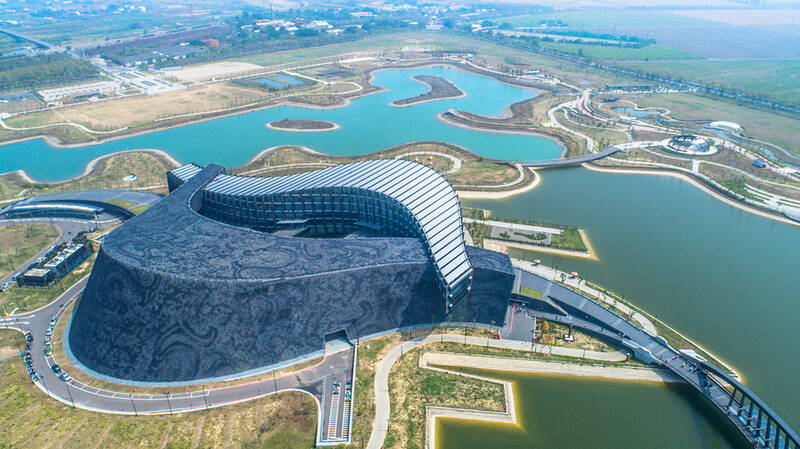Primarily one destination: the National Palace Museum in Taipei. Today, the cultural landscape has evolved, with the Southern Branch of the National Palace Museum presenting a compelling alternative.
Strategically located in Chiayi County, the museum park is more than just a cultural center. It’s a significant part of a campaign to balance regional development in Taiwan. Its establishment has made invaluable historical artifacts accessible to a broader audience outside northern Taiwan, promoting the even distribution of cultural resources. By attracting tourists from all over, this initiative also boosts local economic growth.
To offer visitors rich cultural experiences, the architecture of the museum has a unique beauty. The main building merges contemporary design with traditional Asian elements, presenting a streamlined appearance. The inspiration comes from brush strokes used in Chinese ink painting. A curved path from the building leads to Zhimei Bridge, which elegantly arches over an artificial lake in the south. The bridge doesn’t have a pier, giving the illusion of floating above the surface of the water when viewed from a distance.

Photo: Wikimedia Commons / 照片:維基共享資源提供
Inside the museum, a rich cultural heritage awaits visitors. Permanent exhibitions display precious national treasures such as the Jadeite Cabbage alongside various collections. As for limited-time exhibitions, the museum will host one on the Ryukyu Kingdom starting from this September, with some artifacts on loan from museums in Japan. This exhibition will shed light on the kingdom’s critical role in trade via sea routes and cultural exchanges between nations throughout history. Additionally, in support of cultural diversity, the museum is the first of its kind in Taiwan to include a Muslim prayer room.
Offering a comprehensive perspective on Asian art and history, the museum invites visitors to explore the multiple narratives that have shaped our world.
十年前,熱衷欣賞百年歷史文物的遊客在臺灣主要只有一個目的地:臺北的國立故宮博物院。如今,隨著文化地景的發展,國立故宮博物院南部院區儼然成為了另一個吸引人的替代方案。
位於嘉義縣的這座博物館園區地理位置優越,不僅只是一個文化中心。它是臺灣平衡區域發展的重要一環。南院的建立使得無價的歷史文物對北臺灣以外更廣大的民眾不再遙不可及,同時促進了文化資源的平衡分配。藉著吸引各地遊客,這項倡議也推動了當地經濟的增長。
為了提供豐富的文化體驗,博物館的建築獨具美感。主建築融合了現代設計和傳統亞洲元素,呈現出流線型外觀。其靈感來自中國水墨畫的筆觸。一條曲徑從主建築通往至美橋,此座橋優雅地跨越南邊的人工湖。橋樑沒有橋墩,遠看時彷彿漂浮在水面上。
在博物館內,豐富的文化遺產等待著遊客。常設展覽展示了如翠玉白菜等珍貴國寶及其他多種藏品。特展方面,博物館將於今年九月舉辦一個關於琉球王國的展覽,部分展品將從日本的博物館借展。本次展覽將呈現歷史上琉球王國在海上貿易航線和國家間文化交流中所扮演的關鍵角色。此外,為了支持文化多樣性,故宮南院是全臺首家設有穆斯林祈禱室的博物館。
故宮南院提供對亞洲藝術和歷史的全面視角,邀請遊客探索那些形塑我們世界的眾多敘事。
MORE INFORMATION
artifact n. (尤指具有史學價值的)人工製品
landscape n. 地景;形勢
invaluable adj. 非常寶貴的;無價的
streamlined adj. 有流線造型的
pier n. 橋墩
national treasure 國寶
comprehensive adj. 全面的;詳盡的
narrative n. (對特定事件的)陳述
KEY VOCABULARY
1. compelling adj. 引人入勝的;令人信服的
The novel’s compelling storyline kept readers engaged from beginning to end.
這本小說情節引人入勝,吸引讀者從頭讀到尾。
2. strategically adv. 策略性地
The event was strategically planned to attract as many visitors as possible.
這場活動經過策略性地規劃,以吸引盡可能多的遊客。
3. campaign n. (尤指政治、軍事、商業的)活動
The political campaign aimed to inspire voters with its message of unity and progress.
這場政治活動以團結和進步為訴求激勵選民。
4. distribution n. 分布;分配
The distribution of wealth among the population is a pressing social problem.
人口財富分配是個迫切的社會問題。
5. inspiration n. 靈感;給予靈感的人或物
The beauty of nature often serves as inspiration for poets and artists.
自然之美常常成為詩人與畫家的靈感。
6. elegantly adv. 優雅地
The dining room was elegantly decorated for the wedding reception.
餐廳裝潢典雅,提供婚宴接待用途。
7. arch v. (使)成拱形
Jim arched his back as he stretched, feeling the tension released from his muscles.
吉姆伸展時將背往後彎,覺得肌肉緊繃舒緩了不少。
8. loan n. 借出;借入
on loan (from / to) 從……借入/借出給……
The library had the latest bestsellers on loan for eager readers.
這家圖書館有最新暢銷書籍可出借給熱情的讀者。
9. shed light on…… 提供解釋;使……更容易理解(三態 shed-shed-shed)
= throw / cast light on
The documentary shed light on the environmental impact of industrial farming practices.
這部紀錄片說明了工業化的農作行為對環境帶來的衝擊。
學習音檔: https://magazine.english4u.net/Magdata/menu/vtnnc
《空中美語》雜誌APP免費下載: https://www.english4u.net/apps/index.aspx
免費收聽當月《空中美語》雜誌課文朗讀及解析 !
文章由AMC空中美語授權使用: https://www.english4u.net

In an effort to fight phone scams, British mobile phone company O2 has introduced Daisy, an AI designed to engage phone con artists in time-wasting conversations. Daisy is portrayed as a kindly British granny, exploiting scammers’ tendency to target the elderly. Her voice, based on a real grandmother’s for authenticity, adds to her credibility in the role. “O2” has distributed several dedicated phone numbers online to direct scammers to Daisy instead of actual customers. When Daisy receives a call, she translates the scammers’ spoken words into text and then responds to them accordingly through a text-to-speech system. Remarkably, Daisy

Bilingual Story is a fictionalized account. 雙語故事部分內容純屬虛構。 Emma had reviewed 41 resumes that morning. While the ATS screened out 288 unqualified, she screened for AI slop. She could spot it a mile away. She muttered AI buzzwords like curses under her breath. “Team player.” “Results-driven.” “Stakeholder alignment.” “Leveraging core competencies.” Each resume reeked of AI modeling: a cemetery of cliches, tombstones of personality. AI wasn’t just changing hiring. It was draining the humanity from it. Then she found it: a plain PDF cover letter. No template. No design flourishes. The first line read: “I once tried to automate my

Every May 1, Hawaii comes alive with Lei Day, a festival celebrating the rich culture and spirit of the islands. Initiated in 1927 by the poet Don Blanding, Lei Day began as a tribute to the Hawaiian custom of making and wearing leis. The idea was quickly adopted and officially recognized as a holiday in 1929, and leis have since become a symbol of local pride and cultural preservation. In Hawaiian culture, leis are more than decorative garlands made from flowers, shells or feathers. For Hawaiians, giving a lei is as natural as saying “aloha.” It shows love and

1. 他走出門,左右看一下,就過了馬路。 ˇ He walked outside, looked left and right, and crossed the road. χ He walked outside and looked left and right, crossed the road. 註︰並列連接詞 and 在這句中連接三個述語。一般的結構是 x, y, and z。x and y and z 是加強語氣的結構,x and y, z 則不可以。 2. 他們知道自己的弱點以及如何趕上其他競爭者。 ˇ They saw where their weak points lay and how they could catch up with the other competitors. χ They saw where their weak points lay and how to catch up with the other competitors. 註:and 一般連接同等成分,結構相等的單詞、片語或子句。誤句中 and 的前面是子句,後面是不定詞片語,不能用 and 連接,必須把不定詞片語改為子句,and 前後的結構才相等。 3. 她坐上計程車,直接到機場。 ˇ She took a cab, which took her straight to the airport. ˇ She took a cab and it took her straight